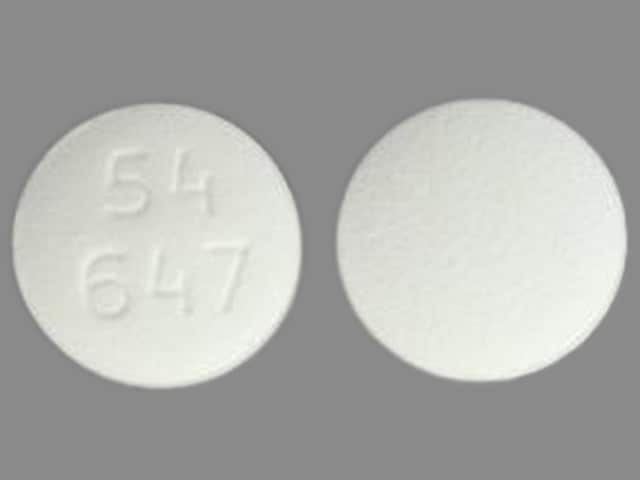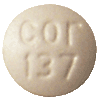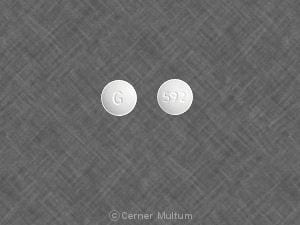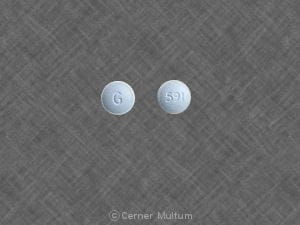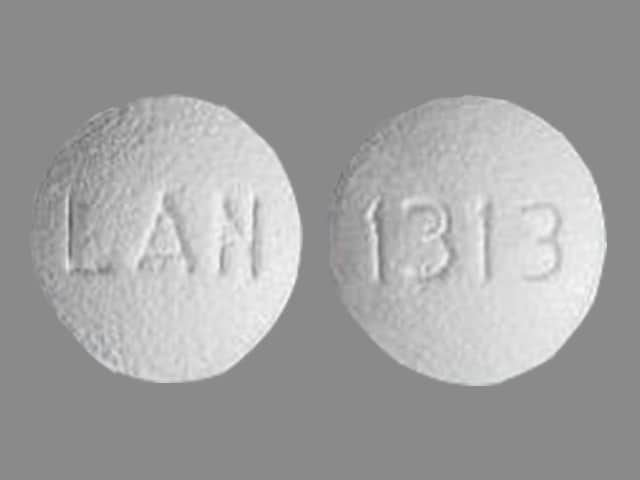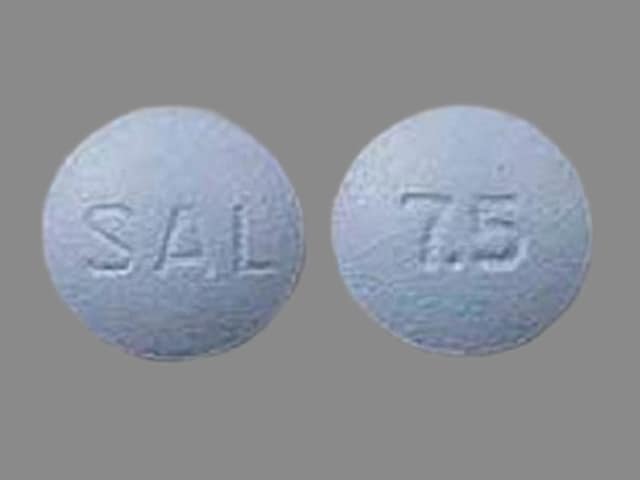Dosage Forms
Excipient information presented when available (limited, particularly for generics); consult specific product labeling.
Tablet, Oral, as hydrochloride:
Salagen: 5 mg
Salagen: 7.5 mg [contains fd&c blue #2 aluminum lake]
Generic: 5 mg, 7.5 mg
Pharmacology
Mechanism of Action
Binds to muscarinic (cholinergic) receptors, causing an increase in secretion of exocrine glands (such as salivary and sweat glands) and increase tone of smooth muscle in gastrointestinal and urinary tracts
Pharmacokinetics/Pharmacodynamics
Excretion
Urine
Onset of Action
20 minutes; Maximum effect: 1 hour
Time to Peak
Serum: 0.85 to 1.25 hours (increased to 1.47 hours with a high-fat meal)
Duration of Action
3 to 5 hours
Half-Life Elimination
0.76 to 1.35 hours; Mild to moderate hepatic impairment: 2.1 hours
Use in Specific Populations
Special Populations: Hepatic Function Impairment
Clearance decreased ~30% in patients with mild to moderate impairment, resulting in an increase in Cmax and half-life.
Special Populations: Gender
Elderly women had Cmax and AUC approximately twice that of elderly and younger men.
Use: Labeled Indications
Xerostomia: Treatment of symptoms of dry mouth from salivary gland hypofunction caused by radiotherapy for cancer of the head and neck; treatment of symptoms of dry mouth in patients with Sjögren syndrome.
Contraindications
Hypersensitivity to pilocarpine or any component of the formulation; uncontrolled asthma; when miosis is undesirable (eg, acute iritis, angle-closure glaucoma)
Dosage and Administration
Dosing: Adult
Xerostomia: Oral:
Associated with head and neck cancer: Initial: 5 mg 3 times daily; may titrate dose based on response and tolerability; usual dosage range: 15 to 30 mg/day; maximum: 10 mg/dose
Sjögren syndrome: 5 mg 4 times daily
Dosing: Geriatric
Refer to adult dosing.
Administration
Avoid administering with high-fat meal. Ensure adequate water intake (dehydration may develop with use).
Storage
Store at 15°C to 30°C (59°F to 86°F).
Pilocarpine (Systemic) Images
Drug Interactions
Acetylcholinesterase Inhibitors: May enhance the adverse/toxic effect of Cholinergic Agonists. Monitor therapy
Beta-Blockers: May enhance the adverse/toxic effect of Cholinergic Agonists. Of particular concern are the potential for cardiac conduction abnormalities and bronchoconstriction. Monitor therapy
Cimetropium: Cholinergic Agonists may diminish the anticholinergic effect of Cimetropium. Monitor therapy
Sincalide: Drugs that Affect Gallbladder Function may diminish the therapeutic effect of Sincalide. Management: Consider discontinuing drugs that may affect gallbladder motility prior to the use of sincalide to stimulate gallbladder contraction. Consider therapy modification
Adverse Reactions
>10%:
Cardiovascular: Flushing (8% to 13%)
Central nervous system: Chills (3% to 15%), dizziness (5% to 12%), headache (11%)
Gastrointestinal: Nausea (6% to 15%)
Genitourinary: Urinary frequency (9% to 12%)
Neuromuscular & skeletal: Weakness (2% to 12%)
Respiratory: Rhinitis (5% to 14%)
Miscellaneous: Diaphoresis (29% to 68%)
1% to 10%:
Cardiovascular: Edema (<1% to 5%), facial edema, hypertension (3%), palpitation, tachycardia
Central nervous system: Pain (4%), fever, somnolence
Dermatologic: Pruritus, rash
Gastrointestinal: Diarrhea (4% to 7%), dyspepsia (7%), vomiting (3% to 4%), constipation, flatulence, glossitis, salivation increased, stomatitis, taste perversion
Genitourinary: Vaginitis, urinary incontinence
Neuromuscular & skeletal: Myalgias, tremor
Ocular: Lacrimation (6%), amblyopia (4%), abnormal vision, blurred vision, conjunctivitis
Otic: Tinnitus
Respiratory: Cough increased, dysphagia, epistaxis, sinusitis
Miscellaneous: Allergic reaction, voice alteration
<1%: Abnormal dreams, abnormal thinking, alopecia, angina pectoris, anorexia, anxiety, aphasia, appetite increased, arrhythmia, arthralgia, arthritis, bilirubinemia, body odor, bone disorder, bradycardia, breast pain, bronchitis, cataract, cholelithiasis, colitis, confusion, contact dermatitis, cyst, deafness, depression, dry eyes, dry mouth, dry skin, dyspnea, dysuria, ear pain, ECG abnormality, eczema, emotional lability, eructation, erythema nodosum, esophagitis, exfoliative dermatitis, eye hemorrhage, eye pain, gastritis, gastroenteritis, gastrointestinal disorder, gingivitis, glaucoma, hematuria, hepatitis, herpes simplex, hiccup, hyperkinesias, hypoesthesia, hypoglycemia, hypotension, hypothermia, insomnia, intracranial hemorrhage, laryngismus, laryngitis, leg cramps, leukopenia, liver function test abnormal, lymphadenopathy, mastitis, melena, menorrhagia, metrorrhagia, migraine, moniliasis, myasthenia, MI, neck pain, photosensitivity reaction, nervousness, ovarian disorder, pancreatitis, paresthesia, parotid gland enlargement, peripheral edema, platelet abnormality, pneumonia, pyuria, salivary gland enlargement, salpingitis, seborrhea, skin ulcer, speech disorder, sputum increased, stridor, syncope, taste loss, tendon disorder, tenosynovitis, thrombocythemia, thrombocytopenia, thrombosis, tongue disorder, twitching, urethral pain, urinary impairment, urinary urgency, vaginal hemorrhage, vaginal moniliasis, vesiculobullous rash, WBC abnormality, yawning
Warnings/Precautions
Disease-related concerns:
- Cardiovascular disease: Use with caution in patients with significant cardiovascular disease; may have difficulty compensating for transient changes in hemodynamics or rhythm induced by pilocarpine.
- Cholelithiasis: Use with caution in patients with cholelithiasis or biliary tract disease.
- Hepatic impairment: Use with caution in patients with moderate impairment; dosage adjustment recommended; use is not recommended in patients with severe impairment.
- Nephrolithiasis: Use caution in patients with a history of nephrolithiasis; may induce smooth muscle spasms, precipitating renal colic or ureteral reflux in patients with nephrolithiasis.
- Respiratory disorders: Use with caution in patients with controlled asthma, chronic bronchitis, or COPD; may increase airway resistance, bronchial smooth muscle tone, and bronchial secretions.
Pregnancy
Pregnancy Considerations
Adverse events have been observed in some animal reproduction studies.
Patient Education
What is this drug used for?
- It is used to treat dry mouth.
Frequently reported side effects of this drug
- Flushing
- Loss of strength and energy
- Chills
- Runny nose
- Passing a lot of urine
Other side effects of this drug: Talk with your doctor right away if you have any of these signs of:
- Severe dizziness
- Passing out
- Shortness of breath
- Swelling
- Abdominal pain
- Fast heartbeat
- Slow heartbeat
- Abnormal heartbeat
- Severe nausea
- Vomiting
- Vision changes
- Eye pain
- Severe eye irritation
- Severe headache
- Increased tears
- Sweating a lot
- Severe diarrhea
- Confusion
- Tremors
- Signs of a significant reaction like wheezing; chest tightness; fever; itching; bad cough; blue skin color; seizures; or swelling of face, lips, tongue, or throat.
Note: This is not a comprehensive list of all side effects. Talk to your doctor if you have questions.
Consumer Information Use and Disclaimer: This information should not be used to decide whether or not to take this medicine or any other medicine. Only the healthcare provider has the knowledge and training to decide which medicines are right for a specific patient. This information does not endorse any medicine as safe, effective, or approved for treating any patient or health condition. This is only a brief summary of general information about this medicine. It does NOT include all information about the possible uses, directions, warnings, precautions, interactions, adverse effects, or risks that may apply to this medicine. This information is not specific medical advice and does not replace information you receive from the healthcare provider. You must talk with the healthcare provider for complete information about the risks and benefits of using this medicine.
